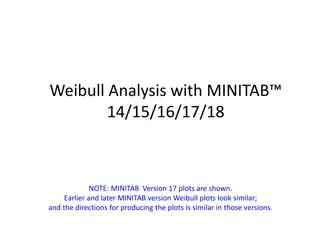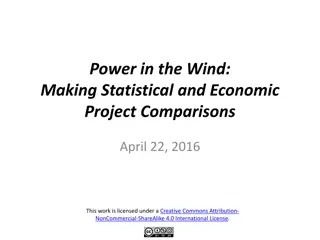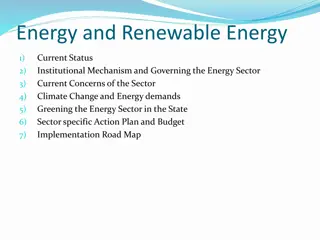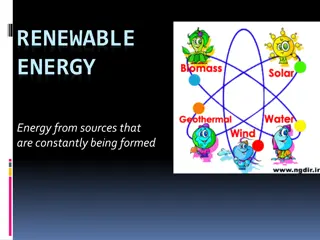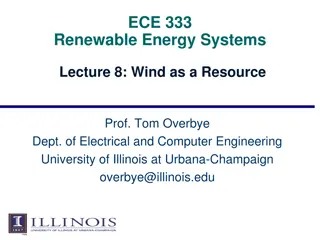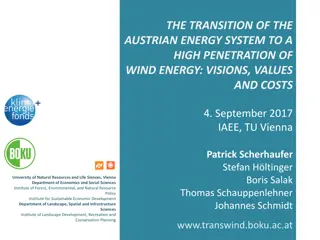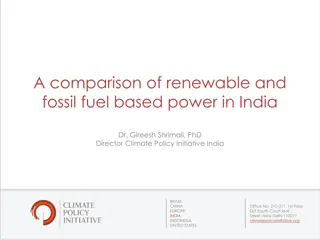Understanding Wind Variations and Weibull Distribution in Renewable Energy
Describing the importance of Weibull distribution in analyzing wind speed variations for optimizing turbine design and estimating electricity generation income. Learn about the parameters needed for the Weibull distribution, methods to estimate these parameters, and how to calculate wind power density using this distribution. Complete exercises to apply knowledge practically.
Download Presentation

Please find below an Image/Link to download the presentation.
The content on the website is provided AS IS for your information and personal use only. It may not be sold, licensed, or shared on other websites without obtaining consent from the author. Download presentation by click this link. If you encounter any issues during the download, it is possible that the publisher has removed the file from their server.
E N D
Presentation Transcript
The Course of Renewable energy MUSTANSIRIYAH UNIVERSITY COLLEGE OF SCIENCES ATMOSPHERIC SCIENCES DEPARTMENT 2019-2020 Dr. Ali Alhafiz FOURTHSTAGE
Welcome Students! TO LECTURE FOUR
Describing Wind Variations: Weibull Distribution The General Pattern of Wind Speed Variations It is very important for the wind industry to be able to describe the variation of wind speeds. Turbine designers need the information to optimize the design of their turbines, so as to minimize generating costs. Turbine investors need the information to estimate their income from electricity generation.
If you measure wind speeds throughout a year, you will notice that in most areas strong gale force winds are rare, while moderate and fresh winds are quite common. The wind variation for a typical site is usually described using the so-called Weibull distribution, The Weibull distribution is often used in the field of life data analysis due to its flexibility, and it can mimic the behavior of other statistical distributions such as the normal and the exponential. The statistical distribution of wind speeds varies from place to place around the globe, depending upon local climate conditions, the landscape, and its surface. The Weibull distribution may thus vary, both in its shape, and in its mean value. As shown in the image, Weibull distribution depend on two parameter scale(A) and shape(k)
Estimating the Weibull Distribution Parameters To obtain a Weibull density distribution is necessary determine shape parameter k and c scale parameter, the common methods for determining k and c are: 1. Graphical method 2. Standard deviation method 3. Moment method 4. Maximum likelihood method 5. Energy pattern factor methods
The most simple method to calculate the two parameters scale(A) and shape(k) is(Standard deviation method) and we can calculated them by using those equations: As we shown the above equation depend on Standard Deviation (S.D) and the mean of wind speed)X( While the scale parameter depends on the mean of wind speed and Gamma function . And the figure down about ( PDF) Probability Density function to Mosul station So, we calculate the Wind power density by Weibull distribution
Exercises: 1. For a wind turbine with rotor diameter 43 meters (a typical size for a 600 kW turbine), calculate the volume and mass of a 1 meter thick parcel of air passing through the plane of the turbine blades (for this exercise, assume a value for the air density of 1.225 kg/m3). 2. Imagine that you have just 2 readings of wind speed: 5 m/s and 15 m/s. Calculate the WPD over the interval of these readings (assume = 1.0 kg/m3 to make the math easier). 3-If you were responsible for calculating the annual average WPD for a potential wind farm to go offshore in the Gulf of Mexico, but weather data was scarce, which method would you use to estimate air density?
Answers to sample exercises 1.) Ans.: The volume of this disk of air equals its cross-sectional area A ( = PI * Diameter2 ) times the disk's depth (D): Vol = * 3.1416 * (43 m)2 * 1 m = 1451 m3 . And its mass equals the volume of air times air density: M = * Vol = 1.225 kg/m3 * 1451 m3 = 1780 kg. (or ~3900 pounds - about the weight of an intermediate car!) 2.) Ans.: WPD = Pwr / A = * * V3 = * 1.225 kg/m3 * (10.0 m/s)3 = 613 watts/m2 (this is an excellent value for WPD) 3.) Ans.: Easy! Remember that WPD is independent of turbine type or size, and only depends on wind speed and density. Hence, the WPD is still 613 watts/m2 , the same as calculated in exercise no. 2.




